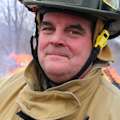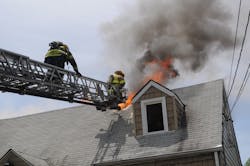ORLANDO – Failures of aerials, for the most part, are things of the past. When they do occur, the failure can often be attributed to operator error. That’s why it’s important aerial operators have appropriate training.
Gregg Gerner, fire chief at the General Motors truck plant in Wentzville, Miss., and former 12-year firefighter with St. Louis Fire Department, offered words of wisdom and practical advice to attendees of the Fire Department Safety Officers Association (FDSOA) annual apparatus symposium on Tuesday.
In a lecture titled “Safe Aerial Operation, It’s All About the Operator,” Gerner, who is also an aerial trainer for Smeal Fire Apparatus, said aerial operations are changing quickly.
“There are more and more electronics being used,” Gerner said. “We’re to the point that we’re asking the computer to do something and the computer responding, ‘yeah, I’ll let you do it.’”
Technology is close to having computer that will deny certain operations out of the parameters, Gerner said.
“Computers will soon say, ‘No, I won’t let you do that,’” he said, describing the envelop kind of controls new aerials have today where firefighters can only use the equipment in the correct manner.
Today’s technology is very different from yesteryear, Gerner said noting that when New York City decided to go from wood ladders to metal ladders, pundits at the time thought the firefighters in the city had gone crazy.
Then in the 1930s, motorized, power assisted aerials were the rage in the nation, Gerner said, adding the ladders still had to be supported by building by leaning aerials on them.
“Operators had to be operators,” Gerner said. “They had to be very aware of where they were.”
If they over reached, the aerials would tip over, Gerner said. If the aerials were overloaded, they collapse, or tip over or both, he added.
“Aerials had a very long history of tip overs,” he said, noting that aerial operators using the now antique equipment had to be very aware of positioning, follow load charts meticulously, the watch incline meters.
Back then, there aerials had non-rated tips and operators “abused the heck” out of aerials routinely using the tips to knock out windows for ventilation.
Fast forward 50 years and suddenly, there was a new rash of aerial collapses in the late 1980s, Gerner said. In 1993, the feds did a research study to determine what was causing all the collapses, he said.
“They found it was operator error over and over again,” Gerner said.
It was about the same time an industry standard was developed requiring a minimum tip load of 250 pounds, fully extended, horizontally off the side of the apparatus, he said, noting that it was determined an average firefighter in turnout gear would weigh about 250 pounds.
To achieve that standard, the aerials had to be stronger structures, with far more robust outriggers and the apparatus themselves had to be much heavier, he said.
“You’ve got to have counterweight, or ballast, to hold those aerials up."
The standard did its job and aerial failures were dramatically cut down, he said.
“We hear very little about failures these days,” Gerner said, with a notable exception of a particular manufacturer with an identified problem with cables. “The older style aerials are out of the system now and the new aerials are much safer.”
They are still not 100 percent, he said, noting there are still injuries from aerials, and they happen with some frequency, but because they’re not fatalities, they don’t often make news, he said.
Some of those injuries include falls from the basket, and many of those can be attributed to lack of safety harnesses, or non-use, he said.
“How do we stop those,” Gerner said. “We require everyone to hook up to the approve tie off points.”
Other injuries happen from outriggers crushing or pinching firefighters, he said.
“You need to stay away from the outriggers when they are going in and out and down,” Gerner said, noting that many have a distinct alarm that sounds when they are in motion.
Firefighters are also getting their feet crushed by rungs when the aerials are retracted, Gerner said. There are interlocks that stops the aerial retraction at the foot rest at the tip, but too often aerial operators just hit the override automatically and if the firefighter isn’t aware or still on the aerial, feet can be pinched. The solution to that is never hold the override during retraction because that’s what the operator will do during the heat of the battle, he said.
Operators also need to stay away from live wires, he said. The minimum for most normal powerlines is at least 10 feet and, as a rule of thumb, Gerner said for each insulator noticed on high voltage line, two feet must be added. For instance, a powerline with six “mushroom shaped” insulators, operators should stay at least 22 feet away, he said.
“Fire trucks are not insulated,” Gerner said. “Electricity is going to pass right through and go to ground causing damage.”
Operators also need to remember the limitations of short jacking and the problems rotation and extension on that side can cause, he said.
“How you test that ladder day in and day out and how you train with it is how you’re going to do it in the heat of the battle,” Gerner said, adding that at 3 a.m. in a high-stress situation, most operators are going to rely on their training, so the training better be correct.
“Make sure you know what your aerial will do and how will it affect your fireground operations,” Gerner said.
About the Author

Ed Ballam
Ed Ballam served as associate editor for Firehouse. He is the assistant chief of the Haverhill Corner, N.H. Fire Department, and a National Registered EMT. He is also a Deputy Forest Fire Warden for the New Hampshire Division of Forests and Lands. Professionally, he's been a journalist for over 35 years working for a variety of publications, including employment as managing editor of a national fire service trade journal for more than a decade.
